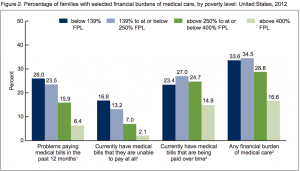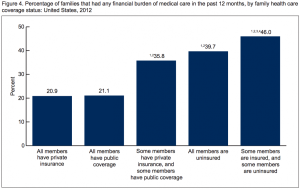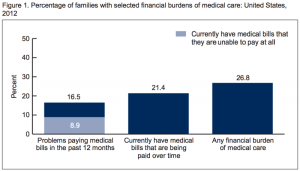A growing proportion of American families are facing money problems related to health care, according to the report, Financial Burden of Medical Care: A Family Perspective, No. 142 in the NCHS Data Brief series from the CDC, published January 2014 and based on 2012 data.
1 in 4 families are dealing with some financial burden due to medical care. “Financial burdens” in health include problems paying medical bills in the past 12 months, shared by 16.5% of families; and medical bills being paid over time, faced by 21.4% of families. 1 in 10 families (9%) have medical bills they are unable to pay at all (the light blue bar in the first column in the first chart).
The report focuses on the family as the unit facing health costs because the costs for one individual in a family impacts everyone in that household.
 The lowest-income families have the hardest time paying medical bills, shown in the second chart. Financial burdens of medical care (ability to pay a bill or paying bills over time) are felt by 1 in 3 families with income below 250% of the Federal Poverty Level (FPL, which in 2014 was under $60,000 for a family of 4).
The lowest-income families have the hardest time paying medical bills, shown in the second chart. Financial burdens of medical care (ability to pay a bill or paying bills over time) are felt by 1 in 3 families with income below 250% of the Federal Poverty Level (FPL, which in 2014 was under $60,000 for a family of 4).
But check out the financial burden of medical care for people above 400% of the FPL – and you’ll see that 16.6% of families had some health care financial burden. The majority of this burden was paying medical bills over time.
Families with children are more likely to have financial burdens of medical care: 1 in 3 families with kids (36%) experience health cost burdens versus 1 in 4 families of two adults with no children.
 Nearly one-half of families in which some members are insured and some uninsured experience the greatest medical cost burdens, shown in the 3rd chart.
Nearly one-half of families in which some members are insured and some uninsured experience the greatest medical cost burdens, shown in the 3rd chart.
When one family member experiences a financial burden of medical care, the entire family may be at risk for financial burden, the report notes.
Health Populi’s Hot Points: The importance of having health insurance, whether public or private, is illustrated in the third chart. Note that 21% of families (1 in 5) whose members have either private health insurance or public coverage faced medical cost burdens. In both cases, health cost burdens impacted the same proportion of families.
Having health insurance matters in America, playing a role in families’ overall financial security. The U.S. is the only developed country in the world that finances health care the way we do, leaving lower-income families more vulnerable in the face of getting sick.
President Obama talked about health insurance last night in his 2014 State of the Union speech. He called out Amanda Shelley, a physician’s assistant and single mom from Arizona, who could not buy health insurance due to a pre-existing condition. She was able to be covered as of January 1, 2014. The President explained that on January 3rd, Amanda felt a sharp pain, and on January 6th, she had emergency surgery. Had Amanda not been covered, the President said, the procedure would have bankrupted her.
“That’s what health insurance reform is all about, the peace of mind that if misfortune strikes, you don’t have to lose everything,” the President concluded.





 Thanks to Feedspot for naming this blog, Health Populi, as a
Thanks to Feedspot for naming this blog, Health Populi, as a